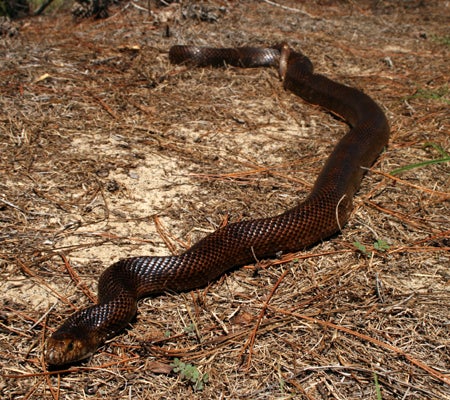SCIENTIFIC NAME:
Pituophis melanoleucus lodingi (Blanchard)
OTHER NAMES:
Black Bull Snake.
STATUS:
Rare and possibly endangered in southern Pine Plains and Hills region west of Mobile Bay. Also known from Buhrstone/Lime Hills of Clarke County. Apparently extirpated from large area around Mobile. Intergrades east of Mobile Bay with Florida pine snake. Currently listed as Threatened by the U.S. Fish and Wildlife Service. HIGHEST CONSERVATION CONCERN.
DESCRIPTION:
A large (max. total length = 188 cm [74 in.]) snake with moderately stout body, short tail, and small head only slightly wider than neck. Anal scute undivided; scales keeled except for some of lowermost rows, rostral scute (at tip of snout) enlarged, curving backward and ending in a point between and behind nostrils. Adults almost uniform black or dark brown, but occasional specimens may have a few white scales or a trace of a pattern. Young tend to have pattern of black blotches on brown background along the posterior three-fourths of body that darkens with age. Intergrades with Florida pine snake in Baldwin and Escambia Counties (see account of that subspecies). Two other black snakes occurring within distribution, the black racer and eastern indigo snake, have smooth body scales. Some eastern hognose snakes are black dorsally, with keeled scales, but snout much more pointed and underside of tail usually conspicuously lighter than belly.
DISTRIBUTION:
Coastal Plain from extreme southeastern Louisiana through southern Mississippi into southwestern Alabama. Recorded in Alabama from Mobile, Clarke, and Washington Counties, and probably occurs in southern Choctaw County (Mount 1975).
HABITAT:
Xeric, fire-maintained longleaf pine forest having sandy, well-drained soils preferred, usually on hilltops, ridges, and toward the tops of slopes, with open canopy, reduced midstory, and dense herbaceous understory. Riparian areas, hardwood forests, or other closed-canopy conditions not regularly used (Duran 1998a). Will use dry, periodically burned open pine or mixed pine-scrub oak forest with abundant groundcover vegetation.
LIFE HISTORY AND ECOLOGY:
Previous reports (Jennings and Fritts 1983, Mount 1986, Sweet and Parker 1990) assumed heavy reliance on gopher tortoise burrows, but a Mississippi radiotelemetry study (Duran 1998b) found them to be rarely used, even where abundant. Much time was spent underground in root channels of rotting pine stumps, and the mean home range size was 47.5 hectares (117 acres). Principal prey is small mammals (cotton rats, mice, young rabbits), also some birds and bird eggs. Although not always prone to bite, a disturbed black pine snake may hiss loudly, vibrate the tail rapidly, and strike repeatedly.
BASIS FOR STATUS CLASSIFICATION:
Limited distribution has dwindled with the declining longleaf pine ecosystem (Duran 1998a). Much habitat has been eliminated through urban development, or conversion into agricultural fields and pine plantations. Most remaining longleaf pine forests on private land are fragmented and degraded by fire suppression. Forest management strategies that suppress fires, increase stocking densities, and remove downed trees and stumps continue to degrade preferred habitats. Extirpated from many formerly occupied habitats around Mobile due to development, fire suppression, road mortality, and direct persecution. Previously among the most frequently encountered snakes on the Mobile County Environmental Studies Center, now apparently extirpated as urban development has engulfed adjacent lands (Jennings and Fritts 1983). Presently considered a candidate for federal listing as threatenedor endangered by the U.S. Fish and Wildlife Service (USFWS 1999).
Author:
David H. Nelson and Mark A. Bailey






